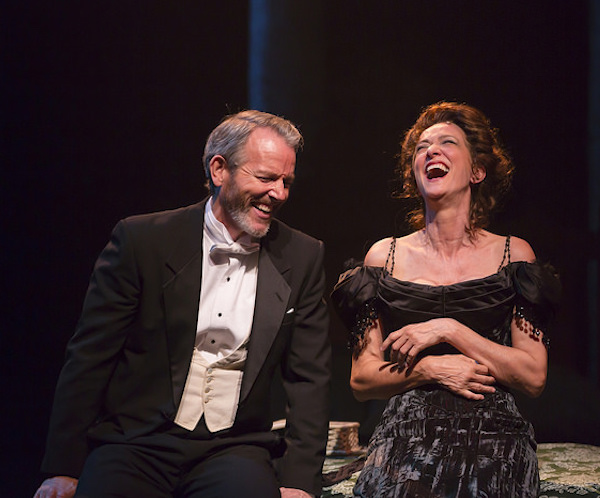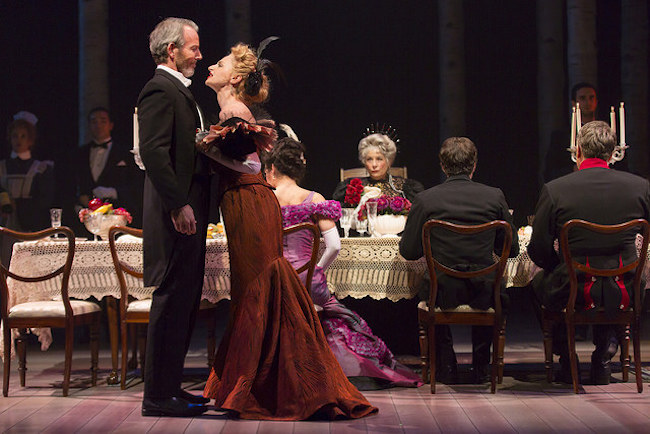Theater Review: “A Little Night Music” — Staged Beautifully, and with Heart
The Huntington Theatre Company’s magnificent production of Stephen Sondheim’s masterpiece A Little Night Music is as good as it gets.
A Little Night Music. Music and lyrics by Stephen Sondheim. Book by Hugh Wheeler. Original orchestration by Jonathan Tunick. Suggested by a film by Ingmar Bergman. Directed by Peter DuBois. Choreographer, Daniel Pelzig. Music director, Jonathan Mastro. Costume design, Robert Morgan. Scenic design, Derek McLane. Huntington Theater Company, BU Theatre, 264 Huntington Ave., Boston, MA, through October 11.

Stephen Bogardus as Fredrik Egerman and Haydn Gwynne as Desirée Armfeldt in the Huntington Theatre Company production of “A Little Night Music.” Photo by T. Charles Erickson.
By Evelyn Rosenthal
I have a confession to make: though I have reviewed or seen many of Stephen Sondheim’s masterful musicals, somehow I had missed his 1973 Tony-winner A Little Night Music, the story of mismatched lovers that gave us his best-known song, “Send in the Clowns.” To prepare for this review, I listened to the cast album and read the book, and by opening night at the HTC’s production, I was ready to be entertained by the score’s glorious music and amused by some of the wittiest dialogue and lyrics ever written. What I wasn’t prepared for, though, was to be completely knocked out by one of the best musical productions I’ve seen in Boston, or anywhere else. For my money, the Huntington’s A Little Night Music is as good as it gets.
Before the show even begins, the audience is treated to a strange, surprising view—the bare back wall of the theater, hung with arrays of radiators, behind a stage strewn with trunks and, under a spotlight, a piano. Has director Peter DuBois transferred the action to some dark industrial setting? Where is the world of the Swedish bourgeoisie around 1900? Then the three women and two men of the musical’s Greek chorus enter to the overture and sing “raise up the curtain, la la la”—as a curtain sweeps across the back wall and the play begins. But that stripped-away backstage peek has done its work, presaging the ironic paean to the grittier aspects of working in theater, “The Glamorous Life.”
Seated in a wheelchair fitted with a tray for solitaire is Madame Armfeldt (Bobbie Steinbach), a former courtesan who lives on her country estate with her granddaughter, Fredrika (Lauren Weintraub), a serious and curious tween-ager. Their lovely prologue sets up the play’s theme, as she tells the girl to be on the lookout for the three “smiles of the summer night” (as in the title of the Bergman film that inspired the musical), which smile “at the follies of human beings”—first the young, then the foolish, and finally, the old. This early scene established the show’s perfect blend of romance, nostalgia, and comedy. The wonderful Steinbach embodies that mixture as the woman at the end of life looking back, getting lost in stories of her romances, and still not above a droll inference as she signals her servant, Frid (Sam Simahk), to wheel her inside, saying, “Time for my”—pause—“nap.” Steinbach’s comic timing is terrific, and she’s not alone. Throughout, DuBois has his cast wring every last laugh out of the witty script.
Haydn Gwynne (who originated the role of Mrs. Wilkinson in the London Billy Elliot and was Tony-nominated for the role on Broadway) brings a sharp, sexy world-weariness to her Desirée Armfeldt, a renowned actress reduced to touring the provinces. The daughter of Madame A. and mother of Fredrika is starring in a “French comedy,” near where her former lover, the lawyer Fredrik Egerman (Stephen Bogardus), lives with his teenage wife, Anne, and his son, the seminary student Henrik (Pablo Torres). The bubbly, extremely young Anne (Morgan Kirner, who gives the character the right notes of sauciness and innocence) is still a virgin after nearly a year of marriage, to the frustration of Fredrik, and is the unwitting love object of the gloomy Henrik. Their number “Now/Later/Soon” reveals their characters as well as the actors’ excellent singing voices in three sections and an overlapping trio.

Stephen Bogardus as Fredrik, Lauren Molina as Charlotte, and Bobbie Steinbach as Madame Armfeldt, in HTC’s “A Little Night Music.” Photo by T. Charles Erickson.
The singing and playing are outstanding throughout. The intricate rhymes of Sondheim’s sparkling lyrics come through clearly, and the gorgeous music—all composed in variations of 3/4 time—is rendered in a full, sweeping sound by the thirteen-piece orchestra conducted by Jonathan Mastro, using half the musicians that the Broadway production had. Adding to the vocal (and comic) feast is the splendid Lauren Molina as Countess Charlotte Malcolm, the neglected wife of Desirée’s current lover, Carl-Magnus (Mike McGowan), a beefy but dimwitted dragoon. Molina, who brought both hilarity and poignancy to her role as Cunegonde in Mary Zimmerman’s extraordinary Candide at the Huntington in 2011, does it again as the long-suffering Charlotte, whose sarcastic barbs go right over her husband’s oblivious head. Also notable is the always winning McCaela Donovan as the Egermans’ maid, Petra, who gives Henrik his first taste of sex and is determined to “celebrate what passes by” before settling down, as she sings in “The Miller’s Son.” Donovan ably handles the shifting tempos and moods of that great song, which features the indelible line, “It’s a very short road / From the pinch and the punch / To the paunch and the pouch and the pension.”
As the mismatched couples gather for a weekend that will eventually sort out their love lives, the scene shifts to Madame Armfeldt’s country house. In a lovely set change, birch trees descend to the stage from on high and the stage glows, from the trees to the costumes in varying shades of white. Robert Morgan’s costumes dazzle throughout, but Desirée’s beautiful off-white lace dress in that Act II opening scene is a work of art. Daniel Pelzig’s fluid choreography mimics the shifting alliances as partners glide and separate and come together again, especially in the opening “Night Waltz,” its reprise in “The Sun Won’t Set,” and the sequences where the quintet voices the characters memories in the lilting “Remember.”
And what about the most famous song from the musical—the one that’s been recorded by Judy Collins, Barbra Streisand, Sarah Vaughn, and countless others? Hearing “Send in the Clowns” in the context of the show of which it’s an integral part is a whole other experience. None of the recorded versions I’ve heard can match the rueful ache of Gwynne’s performance, as Desirée tries to put a brave face on losing her chance at love. It’s a seminal musical theater moment that epitomizes the romance and wry humor of Sondheim’s masterpiece, and, like everything about this marvelous production, it’s done beautifully, and with heart.
Evelyn Rosenthal is the former editor in chief and head of publications at the Harvard Art Museums. She is also a professional singer, specializing in jazz and Brazilian music. She writes about musical theater, books, and music for the Arts Fuse.
Tagged: A Little Night Music, Huntington-Theatre-Company, Peter-DuBois


I agree with most of the positive comments in this review, and would probably agree with more if we could actually have heard the singers’ articulation. The miking of this production (at least from where we sat, balcony center) was terrible. The orchestra blared right in our faces from speakers not far above eye level, and the singers were either drowned out or amped above it at a painful level. Even the spoken dialogue was difficult to understand. Huntington is not a large theater. There was no need for all of this.